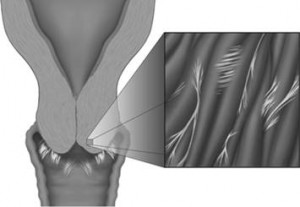Discover relief from menstrual pain with Clear Passage Physical Therapy’s Free Consult and Request Info – learn how their unique, non-surgical approach can address cervical issues, adhesions, and alignment problems that may be causing your discomfort, potentially transforming your menstrual experience without invasive procedures. To learn more, visit our Apply to Therapy page.
When women think of menstrual cramps, they normally think of the constant ache or throbbing pain in the pelvis. We seldom think of stenosis of cervix, also known as stenotic cervix, but it is a key player in dysmenorrhea. Dysmenorrhea is the medical term for abdominal cramps and pain experienced during menstruation. The main symptoms of dysmenorrhea are pain in the abdominal and pelvic region, sometimes accompanied by digestive issues or headaches.
During menstruation, the lining of the uterus detaches and exits the body through the cervix. The cervix is the opening to the uterus. In its natural, midline position, it opens slightly, allowing menstrual blood to pass into the vagina.

But if the cervix has been damaged or adhesions have formed on or near the cervix, the cervix can elicit a great deal of pain during menstruation. If the cervix is pulled or pushed forward, backward, or to one side, it can make the passage of menstrual blood difficult and painful. If adhesions have formed on or near the cervix, the opening of the cervix can be constricted. When blood tries to pass through the constricted opening, it can elicit a great amount of pain.
Because the cervix is protected inside the vagina, many women are not aware of how easily the cervix can be damaged. Sexual intercourse or sexual abuse can physically push the cervix out of alignment. Any surgery in the pelvis can cause adhesions to form that create a condition called stricture of cervix or stenosis cervix. Sexually transmitted diseases can create inflammation that leads to adhesion formation. STDs can also inflame the cervix, making the passage of menstrual blood painful. Radiation therapy causes the same process of adhesion formation and can leave the entire pelvis adhered. Even vaginal or yeast infections can lead to adhesion formation that constricts the cervix or pulls it out of alignment.
Adhesions on the cervix can lead to more than just period pain. Dyspareunia, also known as intercourse pain, is commonly caused by adhesions forming within a woman’s reproductive system. Many women who have adhesions in their reproductive tract or have cervixes that are out of alignment also experience pain during sexual intercourse. The same adhesions that constrict the cervix can also constrict the vaginal walls, leading to pain when stretched.
Unfortunately, this condition often goes untreated because of the personal, sensitive nature of the topic — and reluctance to discuss it with a doctor. If you experience pain during or after intercourse, we encourage you to learn more about this condition that affects millions of women.
To read more about the role of the cervix in intercourse pain, read Three Common Causes of Deep Penetration Pain.
Conventional treatment for adhesions involves laparoscopic surgery to lyse (burn) any adhesions. However, few women are willing to undergo surgery in a very delicate, personal area when their chief complaint is menstrual pain.
Clear Passage offers a unique and effective alternative that directly treats adhesions and the cervix. Using manual physical therapy techniques, our therapists deform and detach adhesions. They also gently enable the cervix to move back to its natural position. Following treatment, many women report that their menstrual pain is significantly decreased or gone. Many women who previously experienced pain with intercourse also report that sex is no longer painful. To learn more about our treatment for menstrual cramps or how we can decrease painful intercourse, see our menstrual pain page or dyspareunia page.
Related Content:
- Menstrual Pain
- The Role of the Cervix in Menstrual Pain
- Patient Story: From Menopause at 35 to Three Kids


